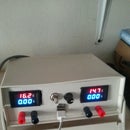Introduction: Current Sensing Circuit
In this simple tutorial, I am going to explain how to measure a current in your circuit. ALL that is here and more you can watch it on my channel VEGEtek on youtube (episode 003).
Step 1: Ways to Measure Current
Ways to measure current:
1- Indirect method: such as current transformers (in the figure) and Hall effect sensors, which relies on Faraday's law of induction to sense current in a circuit and convert it to a proportional voltage.
These methods are suitable more for high current systems.
2- Direct method: which relies on Ohm’s law which states that V = I x R.
This method is suitable for low currents and widely used in electronics devices.
Step 2: Measuring Current by Multimeter
Measuring current using a
Multimeter
1- cut the circuit.
2- use the “current” multimeter input jack, not the voltage one.
3- put the probes as the figure to close the circuit.
Step 3: High-side and Low-side Sensing
High-side and low-side sensing
Direct sensing has 2 methods: High-side and low-side sensing. It depends on the position of the shunt resistor with respect to the load.
This op-amp configuration is called “differential amplifier” which it amplifies the voltage difference between its inputs.
Step 4: Differential Amplifier
Differential amplifier
The op-amp will amplify the voltage difference between its two inputs according to this equation (also in the figure):
V_output = R3/R1 (V2-V1)
If all 4 resistors where the same value
(like 10k) this will be a unity gain differential amplifier which the output voltage is: [ V_out = V2 – V1 ] since R3/R1 = 1/1 = 1. This will give the voltage difference directly as it is.
However, it is common to have a gain of 10 or so in such practical circuits because the voltage difference may be so small, for example:
If shunt resistor is 0.1 Ohms (very common) and the current is 1A, this will result in 1 x 0.1 = 0.1v across shunt resistor, this will mean 0.1v output of the differential amplifier when unity gain is used, so it is 0.1v per 1 A. While using a gain of 10 will mean 1v per 1A which is a lot easy and practical.
Step 5: Video Tutorial With Example
This is the video tutorial that I made:
Please view the video and go apply what I explained in it. I also attached the slides for those who want them!
Please like, share, and subscribe to my channel: https://www.youtube.com/channel/UCXodUSRG2__hTpW4...
THANKS!












